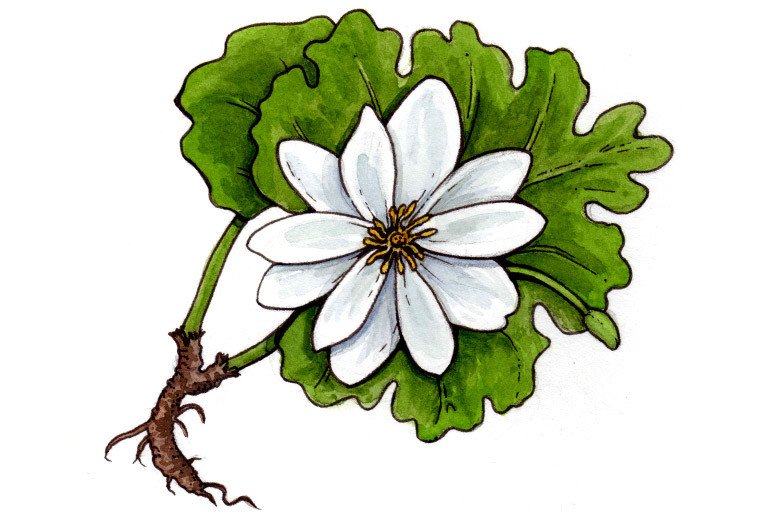The excerpts below are taken from, Our daily lives have to be a satisfaction in themselves; 40 Years of Bloodroot, a collection of essays from the writings of Selma Miriam & Noel Furie, published by Emily Larned.
Bloodroot. Each flower and each leaf of this plant grow separately from the others. But the leaves touch and the roots are interconnected. Individual yet interconnected (p.35). A perennial which dies down to the ground each winter and then returns to life in the spring, the roots being the maintaining force of life (p.91). When cut, the root and stem of this plant, native to eastern North America, seep a bright red substance.
Bloodroot. A feminist, lesbian, collectively-run restaurant and bookstore ‘with a seasonal vegetarian menu’ that sits unassumingly by the Long Island Sound in the Black Rock section of Bridgeport, CT. The name inspired by the qualities of the plant. Has survived…winters (since 1977), sustaining her owners’ feminist vision as well as keeping minds and bodies fed (p.91).

Bloodroot Restaurant Bridgeport, Connecticut
Bloodroot would have to be vegetarian. Only by refusing to use the flesh of other creatures and therefore economizing on the earth’s riches so that more might eat could we call our food feminist (p.92). It is important to explain once again why we, as feminists, are ethical vegetarians. It is amazing to us that so many human animals don’t want to know that other thinking and feeling creatures (the overwhelming majority of them female–poultry) are tortured and killed so that we may eat meat or consume “safely” tested drugs and cosmetics (p.62).
Our vegetarianism stems from a broader base of reasoning than that of personal health. It comes from a foundation of thoughts based on feminist ethics: a consciousness of our connection with other species and with the survival of the earth. Of course, we know that a diet based on grains and legumes, vegetables and fruits is personally healthy. But regardless of how much is learned about food combining, vitamins, basic food group needs, or about problems with pollution or chemical additives to meat, the fact remains that dependence on a meat and poultry diet is cruel and destructive to creatures more like ourselves than we are willing to admit–whether we mean turkeys and cows or the humans starved by land wasted for animal farming purposes to feed the privileged few (p.65).
Bloodroot. The beautiful red-orange color of my dear friend Jodi’s tresses. Jodi was an ethical vegetarian in the deepest sense. She not only expressed her compassion for animals by not eating them, but by loving them, watching out for them and by advocating for them.

Jodi was an ardent supporter and defender of all the feathered and furry. Every living thing, the cats in her home, the birds in her yard, all the plants in her garden, or on her table, she so cherished and protected. Profoundly pained by cruelty, she scanned the news to inform others of injustices against wildlife around the globe or of lost dogs in the neighborhood.
Sadly, Jodi passed away this summer. Her last labor of love was holding a large garage sale to benefit her local animal rescue shelter.
Jodi was the caring mother, wife, sister, daughter, and friend; the one who fed everyone with nourishing meals; and provided the safe harbor for lost waifs and little kitties. She was warm-hearted and light-spirited, though she could be fierce in defense of those more vulnerable. Like the women at Bloodroot, Jodi also served in both formal (and informal) collective restaurants for many years of her life–and too, was an insatiable lover of books. A community of hearts has been broken by the loss of this caring, compassionate, wise, witty, unique and elegant woman–with a twinkle in her beautiful eyes.
I wish I could have taken Jodi to eat at Bloodroot. She would have loved it and felt right at home–though perhaps best if she could be in the kitchen. Not to mention the resident cats who comfortably contribute to and partake in the local ecology. One of them took the empty seat at the table I shared there in the beautiful garden with my co-workers just last week.

Bloodroot Cat
Everything alive changes. It either grows or fades. Perennials spread; sometimes they die out in the center and need to be divided. Sometimes they die and their seeds continue their race. …Those of us who treasure diversity try to keep as many kinds of life going as possible, and that is how we try to live our lives: encouraging growth and life, a spirit and way of living that is perennial life (p.114).
To have known Jodi, was to be touched by her grace and her gifts. Those of us who did, know we are each a little better because of her, her spirit and her way of living. And, for exemplifying that a vegetarian way of life does not reside in its potential capacity to protect our own lives, but the lives of many others.

For those who may be interested, it is worth learning more about the living her-story and radical feminist foundations of Bloodroot. It is quite fascinating and has been captured by the collective’s various cookbooks and prolific writings. Its papers are archived within Manuscripts & Archives at the Yale University Library. Emily Larned’s beautiful hand-stitched book that I have used for my references is also a great resource. And incidentally, a documentary about its founders, Selma and Noel, has just been newly released.
Lastly, if so inspired, please consider a donation in Jodi’s memory to her local animal shelter, Free to Be Me Animal Rescue.
Thank you for listening, sharing, following and supporting my writing. Please subscribe in the sidebar to receive notice of new posts. Comments and greetings always welcome.
Peace and Blessings, Elyn (Yes, it has been a long while.)
Original sources: Bloodroot: Brewing Visions, Lesbian Ethics Vol. 3 No.1 (Albuquerque, NM, edited by Jeanette Silviera)
The Bloodroot Collective. The Second Seasonal Political Palate. (Bridgeport, CT: Sanguinaria Press, 1984)
The Bloodroot Collective. Perennial Political Palate. (Bridgeport, CT,: Sanguinaria Press, 1993)

Bloodroot My Plate
My Plate Song
Call any vegetable Pick up your phone Think of a vegetable Lonely at home / Call any vegetable And the chances are good / That a vegetable will respond to you.
Call and they’ll come to you Covered with dew / Vegetables dream of responding to you / Standing there shiny and proud by your side / Holding your hand while the neighbors decide / Why is a vegetable something to hide?
by Frank (Zappa)










